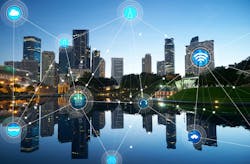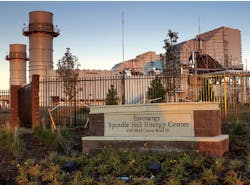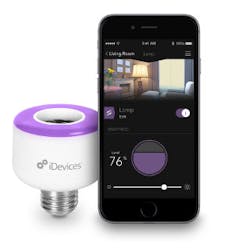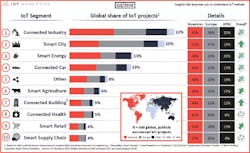IoT is big and buzzy these days. It’s true that billions of IoT-enabled devices are being connected every year. But more important to the electrical wholesaling industry is that many of these IoT sensors are going into electrical products like lighting fixtures, industrial controls on the plant floor, wiring devices and smart utility meters.
Few technologies over the past few decades have sparked the imagination of technologists like the Internet of Things (IoT). IoT means different things to different people, but for the purpose of this article, let’s use the definition published by IHS Markit in its informative “IoT Trend Watch 2017” white paper: “It’s a conceptual framework, driven by the idea of embedding connectivity and intelligence in a wide range of devices… An IoT device has some form of connectivity that allows it to connect to the internet or an IP-addressable device. This connectivity can be wired or wireless.”
While there’s some variances in the estimates of exactly how many IoT devices are now in place or will be deployed over the next few years, IHS Markit expects 15% year-over-year growth to 20 billion enabled devices by 2017. Of most direct interest to manufacturers, distributors, reps and end users in the electrical market is IHS’ estimate that “the industrial sector, driven by building automation, industrial automation and lighting, will account for nearly one-half of new connected devices between 2015 and 2025,” and that this sector is in the middle of a 27.8% compounded annual growth rate surge during that time period. IHS Markit expects to see 3.6 billion IoT devices installed this year. In the next few pages, you will learn about six real-world examples of where IoT technology is already being deployed.
ELECTRIC UTILITIES
The IoT is being used in the utility market in applications ranging from residential smart meters to enormous power plants. GE announced last month that it had signed an agreement with Invenergy llc to deploy its Predix-based Asset Performance Management (APM) software on 13 GE turbines at six gas-operated Invenergy thermal plants in the U.S., with an operating capacity of 3,159 MW. Invenergy is a large privately-held renewable energy provider that has more than 5,500 MW of natural gas-fueled electric generating projects in operation.
Over the past few years, GE spent $1 billion on Predix, its cloud-based software platform with a wide range of predictive maintenance capabilities for industrial, commercial and utility applications. GE said in the press release announcing the Invenergy installation that Predix would “assist plant O&M technicians at these sites to more accurately predict and diagnose equipment failures before they occur to avoid costly unplanned outages through early warning alerts. During this six-month testing phase, a turbine journal bearing issue with early-stage vibration was identified through an early-warning alert. This issue, if left undetected, could have damaged the turbine and resulted in an unplanned outage during peak periods of plant operation.”
“Today, across the United States, the average power generation system is unavailable 6% of the time due to unplanned downtime,” said Ganesh Bell, chief digital officer at GE Power, in the press release. “With GE’s Predix-based APM, we can eliminate in most cases 70% of that unplanned downtime today, and we’re heading rapidly towards 90% coverage. This is the type of outcome that dramatically changes the economics of modern power production, something that’s all the more important in a rapidly-evolving energy landscape.”
In last year’s July issue, Electrical Wholesaling offered an in-depth look at an emerging player in the growing market for IoT-enabled wiring devices, BOSS Controls, Pittsburgh. BOSS is focused on helping end users save energy at the plug-load level with IoT-enabled wiring devices that can be remotely controlled to shut off electrical loads in a customized time sequence. Greg Puschnigg, CEO of BOSS Controls, said in the article that 30% of electrical demand in a building is typically accounted for by plug-load devices. He and his team believe a big market exists in the estimated 5 million buildings under 100,000 sq. ft. in the United States. They have developed IoT-enabled products that not only help building owners slash energy costs, but also collect data on the energy they save and use it to market the saving to electric utilities so they can reduce the amount of power they need to produce during peak demand periods.
THE HOME
We saw yet another example of the interest major electrical players have in IoT with last month’s news that Hubbell Inc., Orange, CT, had acquired iDevices, Avon, CT, a player in the connected home industry. iDevices’ product line includes wall switches, dimmers wall outlets and thermostats that users can control with Apple HomeKit technology.
Of course, Hubbell isn’t the only electrical manufacturer with IoT-enabled residential products in its portfolio. Schneider Electric, Andover, MA, has invested in IoT technology for more than a decade. In addition to its Wiser Home Control Solution for residential applications, the company offers a broad array of predictive maintenance products utilizing its EcoStruxure technology for commercial/industrial applications and is developing IoT solutions for Smart Cities.
PREDICTIVE MAINTENANCE APPLICATIONS
One of the most common applications for IoT-enabled devices in the electrical market is predictive maintenance, where sensors are used on local devices in commercial, industrial and utility applications to collect information on equipment and transmit that data to facility and maintenance personnel. Schneider Electric says its EcoStruxure platform has been deployed in 450,000-plus installations, connecting over 1 billion devices in predictive maintenance and other applications.
The company recently used EcoStruxure and Microsoft’s Azure cloud platform to help Seminole County, FL, with its public water system, which produces 46 million gallons of water daily. The county uses the system to ensure safe drinking water for more than 440,000 residents. Schneider’s IoT-enabled system allows plant managers and operators to view plant data on mobile, handheld and tablet devices and receive critical operational data in minutes, according to information on its website.
According to Wonderware, a provider of industrial software and a Schneider Electric company that was involved with the Seminole County project, before the installation the county had to keep an operator 24 hours a day waiting for alarms to come in and to call or page people. According to information on the Wonderware website, with the new system, “Answers are provided to operators within minutes instead of a half hour to manage operations of Seminole County’s 10 facilities. Operators receive alerts before alarms occur, enabling them to address an issue before it becomes a problem, and before the county’s 440,000 residents know there’s a problem.”
IoT-ENABLED LIGHTING FIXTURES
One of the first examples of IoT-enabled electrical products EW’s editors saw was the Sensity line of outdoor lighting fixtures, which provide not only energy-efficient LED lighting but additional capabilities such as Wifi networking, motion detection, and temperature and power monitoring. Sensity Systems, based in Sunnyvale, CA, was acquired from last year by Verizon, which says a lot about just how much the line is blurring between solid-state lighting, telecommunications and semiconductors.
Verizon realized the value of the real estate that lighting fixtures inhabit, and that by utilizing this space and employing the capabilities of IoT and wireless networking they could create entirely new types of networks in outdoor spaces. Sensity currently has installations in over 40 cities, and says since there are 4 billion outdoor lighting fixtures installed in the market, there’s plenty of room to grow.
In explaining the Verizon acquisition, Sensity Chairman and CEO Hugh Martin said in a press release, “Rapid urbanization is putting a huge strain on city services globally, coupled with inefficiencies caused by an aging infrastructure that currently supports critical functions, such as fire and emergency services, public transportation, lighting, sewer and sanitation systems.
“Sensity realized early on that IoT could be the key to breaking out of this dilemma. We have become the leader in the space by creating a visionary smart city IoT platform and forming a powerful ecosystem of technology partners. With Verizon, we look forward to delivering IoT connected systems on a massive scale to change how cities and communities operate around the world.”
Another lighting manufacturer in the IoT arena is Acuity Brands Inc., Atlanta, GA, which has made two acquisitions over the past few years to build out its wireless indoor position capabilities. It acquired ByteLight Inc., Boston, MA, to combine its own visible light communication (VLC)-enabled drivers and LED lighting platforms with Bytelight’s VLC and Bluetooth low-energy (BLE) technologies, which it combines with smartphone apps and cloud services to transform LED luminaires into indoor location waypoints.
Last year, Acuity acquired GeoMetri LLC, a provider of a software and services platform for mapping, navigation and analytics. Acuity blended the GeoMetri and Bytelight assets with its lighting and control expertise to provide mapping for outdoor spaces and offer data analytics that can lead to operational efficiencies, enhanced safety, and increased revenues in spaces such as airports, shopping malls, logistics centers, universities and health-care facilities, according to an Electrical Marketing report.
Acuity has installed its lighting-based indoor positioning systems (IPS) in nearly 40 million square feet of retail space, according to a report in LEDs Magazine. The company is clearly pumped about the potential of IoT-enabled lighting systems. In Acuity’s most recent quarterly report, Vernon Nagel, the company’s chairman, president and CEO said, “Even though demand was subdued (in 1Q 2017), we have continued to invest in areas we believe have longer-term growth potential. These areas include, among others, the expansion of our lighting and building management solutions portfolios, as well as our Internet of Things software platform. It provides customers with a smart infrastructure that enables endless possibilities to enhance the utilization of their space through better human interaction and greater asset and employee productivity.
“We believe the lighting and lighting-related industry as well as building management systems will experience solid growth over the next decade, particularly as energy and environmental concerns come to the forefront along with emerging opportunities for digital lighting to play a key role in the Internet of Things. We believe we are uniquely positioned to fully participate in this exciting industry.”
SMART CITIES
Installed in 2015, GE’s LightGrid network in downtown San Diego, CA, was the first of the company’s Intelligent Cities’ installations. It includes more than 3,000 city street lights and saves the city more than $254,000 annually in energy and maintenance costs. According to a GE press release, the lights are equipped with sensors and computer-vision software that can pull parking and other data for real-time analysis into Predix, GE’s cloud-based platform for the Industrial Internet.
IoT seems to be one of those topics that folks like to talk about in the abstract, and it’s easy to get bogged down in riffs on technical standards, system configurations and analysts’ 35,000-foot projections for the growth of this technology. We hope this article brings the discussion back down to earth and gives you some ideas of what’s really happening with IoT in Main Street applications.
Sidebar
25 IoT Applications You Might Not Have Seen Yet
EW’s editors found a bunch of interesting IoT applications by browsing the internet. We found the post “50 Sensor Applications for a Smarter World” at www.libelium.com to be particularly interesting. Libelium is a provider of IoT products and software. Below is a taste of them.
1. Monitor vibration and the condition of materials in bridges and buildings.
2. Watch vehicles and pedestrians on roads and sidewalks to suggest better driving and walking routes.
3. Intelligent and weather-adaptive lighting in street lights.
4. Detect how much rubbish is in garbage containers to optimize trash collection routes.
5. Early warning of system maintenance issues on airplanes.
6. Intelligent highways with embedded IoT sensors that generate warning messages about climate conditions, accidents or traffic jams.
7. Detection of forest fires by monitoring potential fire conditions and/or combustible gases.
8. Snow level measurement.
9. Landslide and avalanche prevention.
10. Monitoring soil moisture, vibrations and earth density to detect dangerous patterns in land conditions.
11. Detection of leaks of chemicals or waste in rivers.
12. Remote monitoring of swimming pool conditions.
13. Detection of liquid presence outside tanks and pressure variations along pipes.
14. Monitoring perimeter access in restricted areas.
15. Measuring radiation levels at nuclear plants and presence of gas leaks along pipelines and other oil & gas locations.
16. Tracking shipping containers.
17. Payment processing at public events, on public transportation, etc.
18. Checking inventory on shelves in warehouses.
19. Monitoring indoor air quality.
20. Early detection of maintenance issues in cars and trucks.
21. Watching moisture conditions in farmers’ fields.
22. Tracking animals in grazing pastures.
23. Monitoring availability of parking spaces.
24. Monitoring of condition of artifacts in museums.
25. Fall alerts for hospital patients, or elderly and disabled people living independently.
About the Author
Jim Lucy
Editor-in-Chief of Electrical Wholesaling and Electrical Marketing
Jim Lucy has been wandering through the electrical market for more than 40 years, most of the time as an editor for Electrical Wholesaling and Electrical Marketing newsletter, and as a contributing writer for EC&M magazine During that time he and the editorial team for the publications have won numerous national awards for their coverage of the electrical business. He showed an early interest in electricity, when as a youth he had an idea for a hot dog cooker. Unfortunately, the first crude prototype malfunctioned and the arc nearly blew him out of his parents' basement.
Before becoming an editor for Electrical Wholesaling and Electrical Marketing, he earned a BA degree in journalism and a MA in communications from Glassboro State College, Glassboro, NJ., which is formerly best known as the site of the 1967 summit meeting between President Lyndon Johnson and Russian Premier Aleksei Nikolayevich Kosygin, and now best known as the New Jersey state college that changed its name in 1992 to Rowan University because of a generous $100 million donation by N.J. zillionaire industrialist Henry Rowan. Jim is a Brooklyn-born Jersey Guy happily transplanted with his wife and three sons in the fertile plains of Kansas for the past 30 years.



